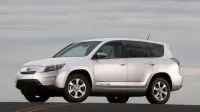Toyota: solid-state batteries coming in 2020, 3-4 times better than li-ion

As for Toyota’s limited interest in lithium ion batteries, they are present in the Toyota RAV4 EV (pictured) and the Toyota Prius V, but nickel metal hydride batteries have been the mainstay in the automaker’s hybrid lineup for years. Solid state and lithium air batteries have advantages over li-ion and NiMH batteries. They’re smaller and use less expensive materials than li-ion, such as rare earth metals.
There are obvious benefits to solid-state batteries. The liquid electrolyte found in li-ion batteries is replaced with a solid material (hence the name), and solid-state packs are more compact and stable, allowing a higher voltage to be packed into a smaller space, Suzuki said. Toyota has been working on solid-state batteries for years and might be taking the lead over competitors such as Sakti3 and Planar Energy in the plug-in vehicle market.
With lithium air batteries, the lithium cathode used in li-ion batteries is replaced with material that interacts with oxygen. It offers much higher density than current li-ion batteries.
For Toyota, the goal is to make a battery that has an energy density approaching that of gasoline, Suzuki said, because li-ion batteries can only offer electric vehicles limited range because these batteries typically have an energy density only one-fiftieth that of a tank of gasoline. While they’re still years away, solid-state or lithium-air batteries may provide the solution Toyota’s been looking for.




